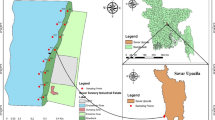Abstract
Belgrade, capital city of Serbia, has over 1,600,000 inhabitants and over 400,000 vehicles trafficking every day on its streets. The investigation of soil pollution was performed by sequential extraction analysis to investigate the availability of potentially toxic metals (Zn, Cd, Pb, Co, Ni, Cu, Cr and Mn) under different oxidation and pH conditions. All investigated metals were mainly extracted from soils with neutral or acidic extractants. Serious pollution was observed along roads and streets with high traffic frequency, but Pb and Ni pollution was the highest since their concentrations exceed both soil Serbian standard and Canadian guidance values and is characteristic for all investigated sites. Cd, Cu, Cr and Zn concentrations are moderately high since they are between Canadian guideline and Serbian standard.




Similar content being viewed by others
Notes
Although arithmetic mean, geometric mean, median and standard deviation values are common statistical values to describe large data sets in our case only median values are reasonably considered from statistical point of view (Dixon and Massey 1983). Arithmetic mean value and standard deviation value are statistical parameters, relevant only for analytical measurement sets with normal (Gaussian) distribution. Since most of our measurement sets have skewed distributions median, minimum and maximum values are the only remaining statistical parameters that give meaningful average concentrations, appropriate for our discussion.
References
Brookins DG (1988) Eh-pH diagrams for geochemistry. Springer, Berlin, p 175
CCME (Canadian Council of Ministers of the Environment) (2007) Canadian soil quality guidelines for the protection of environmental and human health: summary tables. http://www.ccme.ca/assests/pdf/rev_soil_summary_tbl_7.0_e.pdf
Dixon WJ, Massey FJ (1983) Introduction to statistical analysis, 4th edn. McGraw-Hill, New York, p 672
Gržetić I (2003) Traffic pollution in the streets of Belgrade. J Environ Prot Ecol 4:761–766
Impellitteri CA, Lu Y, Saxe JK, Allen HE, Peijnenburg WJGM (2002) Correlation of the partitioning of dissolved organic matter fractions with the desorption of Cd, Cu, Ni, Pb and Zn from 18 Dutch soils. Environ Int 28:401–410. doi:10.1016/S0160-4120(02)00065-X
Kabata-Pendias A, Pendias H (2001) Trace elements in soils and plants, 3rd edn. CRC Press, Boca Raton, p 331
Keen CL, Ensunsa JL, Watson MH et al (1999) Nutritional aspects of manganese from experimental studies. Neurotoxicology 20:213–223
Li B, Wang Q, Huang B, Li S (2001) Evaluation of the results from a quasi-Tessier’s sequential extraction procedure for heavy metal speciation in soils and sediment by ICP-MS. Anal Sci 17(Suppl):1561–1564. doi:10.1002/9780470511329
Mikutta R, Kleber M, Kaiser K, Jahn R (2005) Organic matter removal from soils using hydrogen peroxide, sodium hypochlorite, and disodium peroxodisulfate. Soil Sci Soc Am J 69:120–135
NIAIST (National Institute of Advanced Industrial Science and Technology) (2005) Atlas of Eh-pH diagrams. Geological Survey of Japan Open File Report No. 419
Nome RA, Mendiguchía-Martínez C, Nome F, Fiedler HD (2001) Theoretical framework for the distribution of trace metals among the operationally defined speciation phases of a sediment. Environ Toxicol Chem 20:693–697. doi:10.1897/1551-5028(2001)020<0693:TFFTDO>2.0.CO;2
OGRS (Official Gazette of Republic of Serbia) (1994) Maximum allowed concentrations of dangerous and harmful substances in soil and irrigation waters, vol 23, pp 553–554
PHI (2007) Air pollution on the territory of Belgrade. Public Health Institute of Belgrade, 1999–2007
Pierce FJ, Dowdy RH, Gridal DF (1982) Concentrations of six trace metals in some major Minnesota soil series. J Environ Qual 11:416–422
Sahuquillo A, Lopez-Sanchez JF, Rubio R, Rauret G, Thomas RP, Davidson CM, Ure AM (1999) Use of a certified reference material for extractable trace metals to assess sources of uncertainty in the BCR three-stage sequential extraction procedure. Anal Chim Acta 382:317–327. doi:10.1016/S0003-2670(98)00754-5
Sakan S, Gržetić I, Djordjević D (2007) Distribution and fractionation of heavy metals in the Tisa (Tisza) River sediments. Environ Sci Pollut Res Int 14:229–236. doi:10.1065/espr2006.05.304
Sansalone J, Ying G (2008) Partitioning and granulometric distribution of metal leachate from urban traffic dry deposition particulate matter subject to acidic rainfall and runoff retention. Water Res 42:4146–4162. doi:10.1016/j.watres.2008.06.013
Shacklette HT, Boerngen JG (1984) Element concentrations in soils and other surficial materials of the conterminous United States. U.S. Geological Survey, U.S. Government Printing Office, Washington, DC. Professional Paper 1270
Tessier A, Campbell PGC, Bisson M (1979) Sequential extraction procedure for the speciation of particulate trace metals. Anal Chem 51:844–851. doi:10.1021/ac50043a017
USDA (2005) Urban soil primer. United States Department of Agriculture, Natural Resources Conservation Service, pp 75. http://soils.usda.gov/use/urban/primer.html
United States Environmental Protection Agency (USEPA) (1983) Methods for Chemical analysis of water and wastes. EPA/600/4-79/020
USEPA (United States Environmental Protection Agency) (1989) Risk assessment guidance for superfund: volume I. Human Health Evaluation Manual (Part A), EPA/540/1-89/002
Vorenhout M, van der Geest HG, van Marum D, Wattel K, Eijsackers HJP (2004) Automated and continuous redox potential measurements in soil. J Environ Qual 33:1177–1182
Ying L, Feng Z, Jie C, Haihua G, Yanbiao G (2007) Chemical fractionation of heavy metals in urban soils of Guangzhou, China. Environ Monit Assess 134:429–439. doi:10.1007/s10661-007-9634-1
Acknowledgments
This project was partly financed by the Ministry of Science and Environmental Protection of Serbia (project no. 146008), and partly by “Yugoimport SDPR” grant what is gratefully acknowledged.
Author information
Authors and Affiliations
Corresponding author
Rights and permissions
About this article
Cite this article
Ghariani, R.A., Gržetić, I., Antić, M. et al. Distribution and availability of potentially toxic metals in soil in central area of Belgrade, Serbia. Environ Chem Lett 8, 261–269 (2010). https://doi.org/10.1007/s10311-009-0215-0
Received:
Accepted:
Published:
Issue Date:
DOI: https://doi.org/10.1007/s10311-009-0215-0




